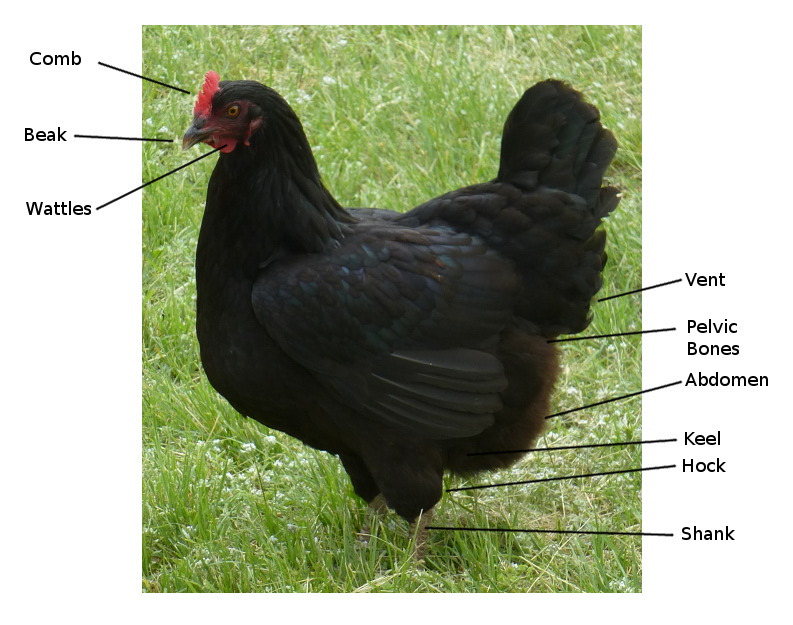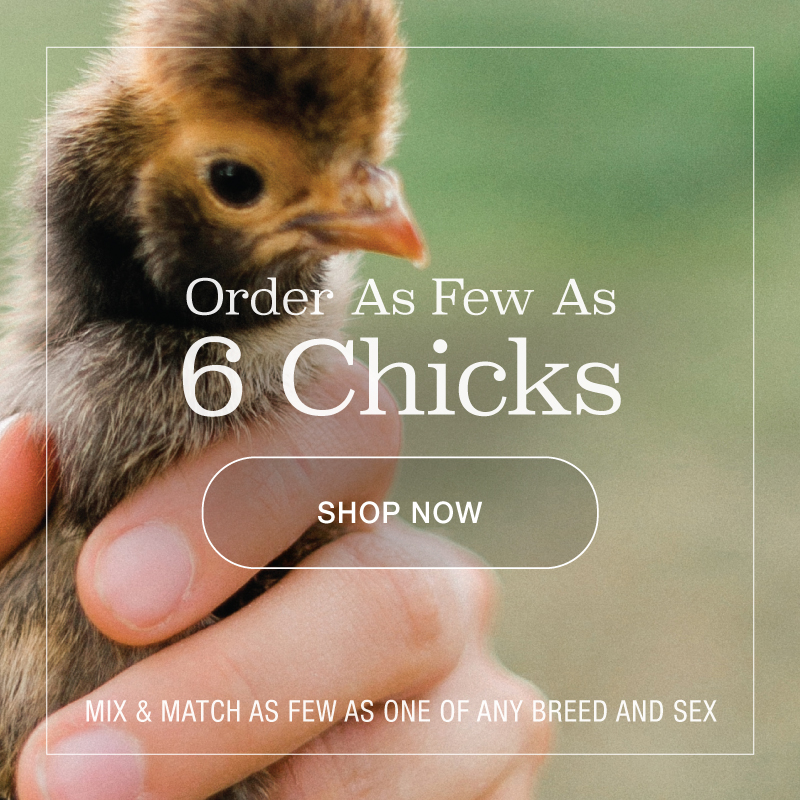
As you raise laying hens, it becomes obvious over time that some hens are more productive than others. Some breeds are better layers, but even from hen to hen within a breed, productivity will vary due to differences in length and timing of molt, health, nutrition, hygiene and other variables. Age also has a big effect on laying — on average, with each passing year, a hen in good health will lay only about 80% as many eggs as she did the previous year.
If you raise chickens for eggs, sooner or later, you’ll want to know which hens are laying and which ones aren’t. How can you tell?
A number of characteristics give a pretty good indication of whether a hen is laying well or not. Some are easy to spot at a distance and will help you to quickly identify suspected non-layers. Others require picking up a hen to examine her more closely.
Let’s look at these.
Pale Yellow Pigmentation
Many (but not all) breeds of chickens have yellow-pigmented skin, legs and beak. The yellow pigment that colors these and other parts of the hen’s body is the same pigment that colors egg yolks. The pigment comes from the hen’s diet.
When a yellow-pigmented hen begins laying, there’s a limited supply of pigment, and since more of it is now needed in the egg yolk, less pigment is available to color the hen’s body. Over time, her yellow body parts will tend to become more pale or “bleached out” looking.
This follows a certain sequence, with the area around the hen’s vent being the first to fade, fading almost immediately. The last areas to fade are the hen’s feet, shanks and hocks. See Storey’s Guide to Raising Chickens or “Molting and Determining Production of Laying Hens” for more details on the sequence.
If you have several hens of the same breed and about the same age and one of them has legs and feet that are much more yellow than the others, it’s likely that she isn’t laying as well or hasn’t been laying as long. This test isn’t foolproof, but it’s a quick way to determine which hens to inspect more closely. (It’s also only applicable to hens with yellow pigmentation, which some breeds don’t have.)
Bright Comb and Wattles
When a hen is laying well, her comb and wattles will tend to be bright red. A non-layer’s wattles will appear more pale.
Behavior: Active and Alert
Because producing eggs takes energy, a laying hen’s nutritional requirements are higher than those of a non-layer. Good layers, therefore, will tend to be active and alert. When food is available, they’ll be among the first to approach and eat it. Non-layers will linger behind, tending to be lazier and more lethargic. Non-layers will also eat their fill and be done eating more quickly than good layers. When observing your hens’ activity levels, it’s good to stand at a distance or partly hidden from view so that you don’t affect their behavior.
Different breeds, of course, differ in demeanor. Leghorns (generally excellent layers) will tend as a group to be very active. By comparison, even a Buff Orpington that is laying very well may seem fairly laid back, so if you have a mixed flock, you’ll need to look at additional characteristics beyond just behavior.
Soft, Pliable Abdomen
Pick up a hen and feel the area below her vent, known as her abdomen. It’s easy to do this if you lay her on her back in one of your arms and probe with the other hand.
Is her abdomen soft and pliable? If so, the hen is likely a layer. If her abdomen is somewhat harder and less flexible, then she’s likely a non-layer, though it’s important to consider that when an egg is forming inside the hen, it will have a hard feel to it that could be mistaken for the hard, inflexible feel of a non-layer.
As with many of these tests, this is somewhat subjective and takes some practice to develop a feel for. If you’ve got a hen that you know through other means is laying well and one that’s not, a good way to develop your skill in identifying layers is to practice on each of these until you can easily tell the difference.
Wide Distance Between Pelvic Bones
You can feel the hen’s pelvic bones slightly below her vent to the left and right sides. This can be done with the hen upright or on her back as when checking her abdomen. The pelvic bones will feel slightly pointy.
With your fingers side by side, measure the distance between the pelvic bones. Can you fit the width of 3-4 fingers in that space? If so, that usually indicates that the hen is laying. A width of no more than two fingers indicates that she’s not laying or not laying consistently.
Another thing to check is the distance between the hen’s vent and her keel. The keel, at the base of the breast in the center of the bird, feels pointy. A distance of 4 fingers’ width indicates a layer. Less than that indicates a hen that’s not laying or at least not laying well.
These measurements apply to full size breeds. When dealing with smaller hens or bantams, scale your measurements down accordingly.
The Vent
The hen’s vent is where eggs come out. Moving back the surrounding feathers, if necessary, examine her vent. Is it moist? Oval? Is it fairly large?
Layers tend to have a large, moist, oval-shaped vent. The vent of a non-layer tends to be smaller, dry and round. If the hen is a breed that is naturally yellow-pigmented, as described above, the area around the vent will tend to be pale in color if she’s laying, even somewhat white or blue. If she’s not been laying, it will be yellow.
Here again, if you can examine both a known layer and a known non-layer, it will help you to identify the differences.
Other Approaches
Trap nesting is another approach that can be used to determine which hens are laying and how well they’re laying. It involves special nests that trap the hens when they lay so that you can positively identify and record who laid each egg before letting her out of the nest. It is more applicable to breeders, but we may discuss it in a future article.
Another approach that might seem obvious, but that won’t work as well in practice, is to temporarily separate your hens into separate cages or coops so you can monitor how each hen lays, individually. The problem with this approach (in addition to the extra time and space it requires) is that moving hens in and out of the flock disrupts their laying, so it can lead to inaccurate conclusions.
Further Notes
Of the tests above, checking the condition of the vent, measuring the spacing of the pelvic bones and keel and checking the pliability of the abdomen are some of the most reliable. Other, more visual checks are quicker and will help you identify potential non-layers at a distance.
As you check your chickens periodically and watch to confirm whether you see them lay or not, you will become better at distinguishing layers from non-layers. By culling your non-layers and using them for meat, you can have a more productive flock and have more space available for your most productive birds.
Your hens will molt, usually once a year. While molting their egg laying will decline or stop. Once the molt is over, egg laying will increase again. It’s not a good idea to cull your non-layers during a molt since that’s when even your best hens aren’t laying well.




I’m expecting my first baby chicks in 2 weeks. I’m absorbing as much information as I can before they arrive enabling me to be smarter about chickens and be a good care taker. This article is very informative and am looking forward to using the information as my girls mature. I can hardly contain my excitement since I was raised on a Missouri Farm and haven’t had chickens to tend for 45 years.
Excellent & very informative article. Thanks because God knows we needed this information since our 30 brown layers are going into their 3nd year & our egg count is decining.
Thanks again
I found this article very informative, I grew up on a poultry farm and never had this much explained or taught to me by my father. Today, I have a very small flock of birds that I get great enjoyment from. I think they trust me and we have a good relationship. At 80 years of age it is pleasurable having pets to care for.
I have a small flock of gold laced Wyandotte’s 15 hens and 2 roosters,they have molted and have been laying quite well. But now they have begun to get very broody, I have six hens now that have gone broody and most are not sitting on eggs even. it seems the broody hens were the layers as well since I have gone from 12 eggs a day down to two. Just wonder if they have produced so impressively that they need a break. this is their 3rd year laying.
Any advice ?
Ray
I learned about chickens back when my Mom was in charge and I also had a Auntie who was my mentor and eveything I learned about chickens I learned from them. Then when my kids were in 4H I learned a whole lot more but the thing I have always relied on 100% is the vent measure to tell my hens were laying or not. And if you are always calm with your chickens as they mature you will never have any trouble checking them. My girls love to be picked and petted. I am a great-grandmother and am hoping these little “greats” pick on these kinds of things, calm & quiet with animals and you have their trust.
Excellent article. I have used these a lot over time, especially the pelvic bone width.